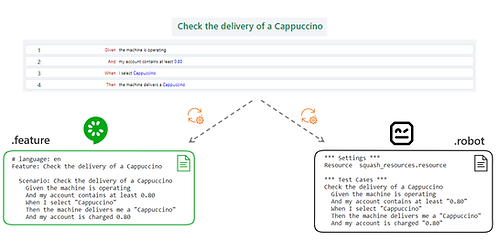Squash features
Test management
Manage and structure a lasting test asset
-
Refine SUT specifications into qualified test requirements and create requirement hierarchies using high-level requirements 👑 to facilitate repository organization and maintenance.
-
Associate your requirements with test cases to measure their coverage.
-
Formalize your tests according to an actions/results approach or a Gherkin formalism to anticipate automation.
-
Facilitate test case maintenance by factoring your tests: write the test once and then variabilize them with data sets.
-
Build test scenarios using test case call functions.
-
Gain productivity when writing test cases with the help of artificial intelligence 💎.
-
Structure your test assets in hierarchical libraries and create transversal repositories shared between projects.


Associating requirements with test cases


Writing a test case in actions/results form
Industrialize and optimize validation
-
Take advantage of advanced planning, organization and prioritization features to optimize test execution effort according to your constraints.
-
Execute your tests using Squash to control manual testing and keep track of results.
-
Optimize your execution plans with a wizard that helps you identify tests to replay based on the results of previous iterations (failed and/or blocked tests, anomaly-related tests, non-regression tests...) 👑.
-
Save time and increase reliability by declaring from Squash anomalies pre-filled with test data, to most bugtrackers on the market (Mantis, Jira 👑, GitLab, Azure DevOps 👑, Redmine 👑, RTC 👑, Tuleap 👑).
-
Leverage Squash's native dashboards to track every phase of your test projects:
-
Check for orphaned requirements and test cases
-
Check the consistency of test case sizes
-
Compare the actual progress of a test campaign against the forecast
-
Identify high-importance, never-executed tests
-
And much more...
-
-
Generate pre-filled Squash reports to speed up your workflow (test book, campaign review 👑 ).
-
Create your own dashboards and use custom templates for reports for customized reporting tailored to your organization.


Execution plan management

Default and customized dashboards

Integrate testing at the heart of agile team practices
-
Synchronize agile objects from Jira or GitLab (user stories, epics 👑, tasks...) as requirements in Squash: testers can easily design their test assets based on these requirements.
-
Validate tickets and organize tests in a sprint logic: each ticket in the sprint benefits from an execution plan automatically fed with the tests that verify it. With Jira and GitLab, Jira sprints or GitLab iterations/milestones are synchronized as sprints in Squash: the tester can thus easily view and test the sprint tickets to be validated.
-
Easily build your execution plans to validate the content of a release: a wizard automatically suggests the scope of test cases to cover a version defined in Jira or a milestone defined in GitLab.
-
Give the Product Owner visibility of acceptance progress in Jira or GitLab:
-
Design phase: progress, coverage monitoring
-
Execution phase: progress, test status, success rate
-
-
Manage your exploratory tests: draw up a charter, prepare, carry out and monitor the test session.

Synchronization of US from GitLab to requirements in Squash

Exploratory testing session
.png)
Exploratory testing session notes
Make the automation process more reliable and ensure the consistency of your assets
-
Analyze and identify tests to be automated in Squash.
-
Manage and track the automation process in Squash, or move it to a Jira workflow 💎.
-
Associate your automated scripts with test cases and exploit their parameters in the scripts: datasets, custom fields of test cases, iterations 💎, test suites 💎 and campaigns 💎.

Workflow between testers and automation engineers
Anticipate and accelerate automation with BDD test cases
-
Write test cases in Gherkin using a simple, intuitive interface featuring auto-completion 💎 and the reuse of keywords that have already been automated thanks to a library of actions 💎.
-
Variabilize your test cases with datasets to promote keyword reuse.
-
Generate the Cucumber or Robot Framework scenario corresponding to a test case in a single click.



Choice of format generated by Squash according to the target technology
Writing a test case in Gherkin
Precise orchestration of automated test execution from within Squash
-
Give test teams control over the definition and execution of automated tests: automated tests can be integrated into Squash execution plans, along with manual tests.
-
Target the environment on which tests are run. Define environment variables that will be accessible in your automated scripts.
-
Access reports generated by test frameworks and studios, as well as summary reports of your automated execution plans, directly from Squash.
-
Keep a history of your automated executions.

Running automated tests in Squash
Integrate functional testing into CI/CD pipelines
-
Easily integrate your automated functional test plans into your pipelines, whatever the technology: GitLab, Jenkins, Azure DevOps, CloudBees CI, XebiaLab XL...
-
Give the test team complete control over plan content and maintenance, without the need for devops.
-
At each runtime, test results and summary reports are stored and historized in Squash. The test team can analyze them there.
-
Define a Quality Gate by specifying minimum success rates for certain types of tests (e.g. 100% for all REST API tests and 95% for user interface tests). The pipeline will be stopped if a success rate is not reached.
-
Report the Quality Gate result in GitLab's Merge Requests.

Quality gate's results in GitLab Merge Requests

Automated test results in Squash